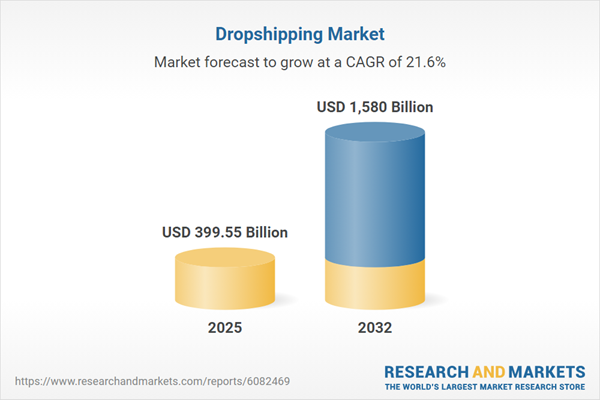Speak directly to the analyst to clarify any post sales queries you may have.
The dropshipping market is entering a pivotal phase marked by trade policy shifts, evolving consumer expectations, and rapid advancements in e-commerce technologies. Industry leaders must align their strategic outlooks to remain agile and maintain a competitive edge in a dynamic global ecosystem.
Market Snapshot: Growth Trajectory and Key Market Metrics
The dropshipping market grew from USD 332.27 billion in 2024 to USD 399.55 billion in 2025. The sector maintains strong momentum, with a CAGR of 21.56%, and is projected to reach USD 1.58 trillion by 2032. This performance is reinforced by surging e-commerce adoption, diversification of consumer preferences, and adoption of advanced fulfillment technologies.
Scope & Segmentation: Exploring the Dropshipping Value Chain
This report examines the dropshipping market’s multi-layered structure, providing deep segment-level insights.
- Product Types: Automotive, Books & Stationery, Electronics (Headphones & Earbuds, Smart Home Devices, Smartphones, Wearables), Fashion & Apparel, Food & Beverages, Health & Beauty (Beard Care Products, Hair Care Tools & Accessories, Nail Care, Skincare Products), Home & Kitchen (Bedding & Linen, Furniture, Home Décor, Kitchen Appliances), Pet Supplies, Sports & Outdoors (Fitness Equipment, Outdoor Gear), Toys & Games.
- Locations: Cross-border Dropshipping, Domestic Dropshipping.
- Customer Types: Business-to-Business (B2B), Business-to-Consumer (B2C).
- Sales Channels: eCommerce Marketplaces, Social Commerce.
- Business Sizes: Large-Scale Enterprises (SMEs), Small & Medium Enterprises (SMEs).
- Shipping Modes: Air Freight, Road/Rail Freight, Sea Freight.
- Key Regions: Americas (North America: United States, Canada, Mexico; Latin America: Brazil, Argentina, Chile, Colombia, Peru), Europe, Middle East & Africa (United Kingdom, Germany, France, Russia, Italy, Spain, Netherlands, Sweden, Poland, Switzerland, UAE, Saudi Arabia, Qatar, Turkey, Israel, South Africa, Nigeria, Egypt, Kenya), Asia-Pacific (China, India, Japan, Australia, South Korea, Indonesia, Thailand, Malaysia, Singapore, Taiwan).
- Leading Companies: AliDropship, AppScenic Ltd, AUTODS LTD., Cin7 Americas, Inc., Doba Inc., DropCommerce, Dropified LLC, Focus Technology Co., Ltd., Gooten Inc., GreenDropShip, Inc., Inventory Source LLC, Leeline, Megagoods Inc., Modalyst, Inc., Printify, Inc., SaleHoo Group Limited, Sellvia, Shopify Inc., Spocket Inc., Syncee Ltd., Wholesale2B, Worldwide Brands, Inc., Zendrop, Inc.
Key Takeaways for Decision-Makers
- Shifting global trade dynamics are compelling dropshippers to develop adaptive supply chains and optimize tariff management strategies.
- Adoption of mobile-optimized storefronts and AI-powered product recommendations is reshaping consumer engagement and operational efficiency.
- Sustainability standards are driving investments in carbon-efficient logistics and recyclable packaging across product lines and territories.
- Regional nuances, such as regulatory harmonization in the EU or advanced digital infrastructure in North America, continue to influence market entry and expansion priorities.
- Diversification of supplier bases and technology use—such as warehouse automation and predictive analytics—are critical levers for mitigating risk and enhancing responsiveness.
Tariff Impact: Navigating U.S. Policy Adjustments
Recent United States tariff policy changes are driving a reassessment of dropshippers’ sourcing and pricing structures. Organizations are managing increased cost pressures by engaging partners in less-impacted regions and leveraging customs and logistics expertise to minimize regulatory exposure. These measures enable continuity and cost competitiveness, while also accelerating realignment of supply networks to meet evolving duty structures.
Methodology & Data Sources
This research combines quantitative analysis of industry data with qualitative expert interviews. Primary and secondary data collection, market intelligence synthesis, and rigorous data validation underpin all insights, ensuring decision-makers receive actionable, reliable recommendations.
Why This Report Matters
- Facilitates informed decision-making, aligning operational strategies with emerging trade and technology trends.
- Provides granular segmentation and regional insights for market sizing, risk assessment, and competitive benchmarking.
- Enables leaders to evaluate new technologies and evolving logistics models in the dropshipping value chain.
Conclusion
The dropshipping market demands continual adaptation to regulatory, technological, and consumer shifts. Data-driven strategies, proactive risk management, and investment in sustainable and agile logistics models are essential for sustainable growth and long-term competitive positioning.
Table of Contents
3. Executive Summary
4. Market Overview
7. Cumulative Impact of Artificial Intelligence 2025
Companies Mentioned
The companies profiled in this Dropshipping market report include:- AliDropship
- AppScenic Ltd
- AUTODS LTD.
- Cin7 Americas, Inc.
- Doba Inc.
- DropCommerce
- Dropified LLC
- Focus Technology Co., Ltd.
- Gooten Inc.
- GreenDropShip, Inc.
- Inventory Source LLC
- Leeline
- Megagoods Inc.
- Modalyst, Inc.
- Printify, Inc.
- SaleHoo Group Limited
- Sellvia
- Shopify Inc.
- Spocket Inc.
- Syncee Ltd.
- Wholesale2B
- Worldwide Brands, Inc.
- Zendrop, Inc.
Table Information
| Report Attribute | Details |
|---|---|
| No. of Pages | 186 |
| Published | November 2025 |
| Forecast Period | 2025 - 2032 |
| Estimated Market Value ( USD | $ 399.55 Billion |
| Forecasted Market Value ( USD | $ 1580 Billion |
| Compound Annual Growth Rate | 21.5% |
| Regions Covered | Global |
| No. of Companies Mentioned | 24 |









